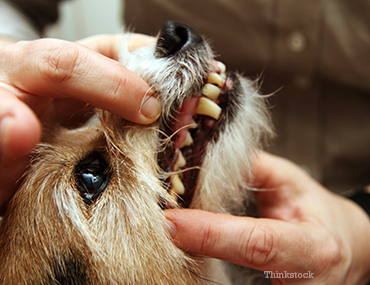|
Posts by: Dr. Ruth MacPete, DVM
Signs your pet may have a fractured tooth
Treatment of a tooth fracture
Treatment depends on the extent of the damage and which part of the tooth is involved. Not all broken teeth require treatment. Ultimately, whether treatment is needed or not depends on which part of the tooth is damaged. When the pulp cavity is not affected your veterinarian may need to merely file the rough or sharp edges of the chipped tooth down or, if it is not sharp, they may recommend just monitoring the tooth. More complicated tooth fractures involving the pulp cavity require endodontic treatment; this involves a root canal or extraction. Root canals save the tooth and are less invasive and traumatic than extractions. Doing nothing is not a viable option as this type of tooth fracture can be quite painful and lead to complications. After all, if you broke your tooth you would immediately see your dentist for treatment; a fractured tooth is very painful. Well, the same holds true for your pet. Ultimately, the goal of treatment is to maintain a vital tooth and—at a minimum—alleviate pain and prevent infection and other complications. Complications of a tooth fracture Left untreated, complicated tooth fractures can lead to a number of different problems. Tooth fractures involving the pulp cavity can allow bacteria present in the mouth to get into the pulp canal and lead to an infection or abscess. This in turn can lead to infections around the tooth root (periapical tooth infections), bone loss, the development of an abnormal connection between the oral cavity and nasal cavity (oronasal fistula), chronic sinus infections, or mandibular fractures if the lower teeth are involved. If you think your pet has a broken, chipped or damaged tooth, be sure to have your veterinarian take a look at your pet’s mouth as soon as possible. Also, don’t forget to bring your pet in for regular check-ups. I have personally discovered many animals with dental problems during a routine examination. Lastly, I encourage pet owners to get into the habit of brushing their pet’s teeth and checking their pet’s mouth regularly in order to identify problems early. And of course, watch what your pet is chewing on and stay away from hard objects that may damage teeth. For more information about dental disease or caring for your pet’s teeth speak with your veterinarian. If you have any questions or concerns, you should always visit or call your veterinarian -- they are your best resource to ensure the health and well-being of your pets. Reviewed by: Celeste Clements, DVM, DACVIM Reviewed on: Thursday, January 7, 2021
43 Comments
|
Archives
November 2023
Categories |
|
HELPFUL INFORMATION
Office Hours
Monday: 8AM – 6PM Tuesday: 8AM – 6PM Wednesday: 8AM – 8PM Thursday: 8AM – 8PM Friday: 8AM – 5PM Saturday: 8AM - 12PM Sunday: CLOSED |
LOCATION
AND DIRECTIONS Salem Veterinary Hospital
2159 Lynnhaven Parkway, Suite 105B Virginia Beach, VA 23456 |
CONNECT
WITH US! |
Site powered by Weebly. Managed by IDEXX Laboratories


 RSS Feed
RSS Feed
